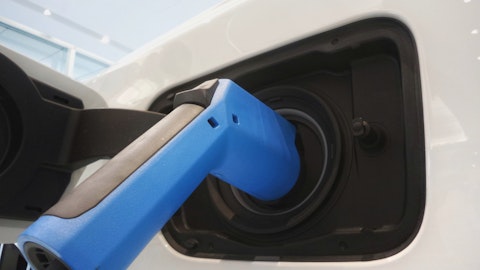The Hain Celestial Group, Inc. (NASDAQ:HAIN) Q2 2023 Earnings Call Transcript February 7, 2023
Operator: Greetings, and welcome to The Hain Celestial Group Second Quarter Fiscal 2023 Earnings Call. At this time, all participants are in a listen-only mode. A question-and-answer session will follow the formal presentation. As a reminder, this conference is being recorded. I would now like to turn the conference over to your host, Chris Mandeville with ICR. Thank you. You may begin.
Chris Mandeville: Good morning and thank you for joining us on Hain Celestial’s second quarter fiscal 2023 earnings conference call. On the call today are Wendy Davidson, President and Chief Executive Officer; and Chris Bellairs, Executive Vice President and Chief Financial Officer. During the course of this call, the management may make forward-looking statements within the meaning of the federal securities laws. These include expectations and assumptions regarding the company’s future operations and financial performance. These statements are based on management’s current expectations and involve risks and uncertainties that could differ materially from actual events and those described in these forward-looking statements.
Please refer to Hain Celestial’s annual report on Form 10-K, quarterly reports on Form 10-Q and other reports filed from time to time with the Securities and Exchange Commission as well as its press release issued this morning for a detailed discussion of the risks that could cause actual results to differ materially from those expressed or implied in any forward-looking statements made today. The company has also prepared a presentation inclusive of additional supplemental financial information, which is posted on Hain Celestial’s website under the Investor Relations heading. Please note, management’s remarks today will focus on non-GAAP or adjusted financial measures. Reconciliations of GAAP results to non-GAAP financial measures are available in the earnings release and the slide presentation accompanying this call.
This call is being webcast, and an archive of it will be made available on the website. And now I’d like to turn the call over to Wendy.
Wendy Davidson: Thank you, Chris, and good morning, everyone. We appreciate you joining us for my first earnings call since joining Hain. First, let me thank Mark Schiller for his leadership of the company over the past four years through a time of significant transformation of our company portfolio and operating model. In the past month, Mark has been a valuable resource in my transition into the company and the role. I’m only a few weeks into the job, but I’ve had the opportunity to review many of our key commercial, supply chain and brand plans across our businesses. And in the coming weeks, I will have a greater opportunity to visit our locations and connect more with our local teams to further my understanding. What I have learned thus far has only confirmed my decision to join Hain and our opportunity to build a sustainable, profitable and high-growth business with leading brands in the better-for-you consumer space.
During my early weeks with our team, I have been impressed the potential of our brands, many of which are number one or number two in their category. However, while much work has been done to simplify the portfolio and generate productivity, it is apparent that a variety of challenges have prevented sustained investment to scale our brands. In fact, I’ve noticed our brand building spend has historically been far below industry average. And in certain instances, we have been off air for over a year on some of our largest brands. Moving forward, I anticipate committing greater support behind those brands, and eventually spending more in line with our category growth peers with sustained brand building support. I see strong potential to drive growth in our categories and brands with expanded reach across channels and geographies.
But to do so, we will need to ensure we are investing in the organizational capacity and capabilities to enable accelerated growth. I’m impressed with the talent on our team and appreciate the time and efforts they have spent to help me more fully understand the state of the business, our capabilities and our opportunities. I’m encouraged by the progress in advancing end-to-end supply chain improvement. And while we are in the early stages of integrated business planning implementation, in my experience, I’ve seen firsthand the impact this can have in improving planning and forecasting discipline across the business. In our international business, we will be adding resources in our commercial capabilities to improve our distribution and end market performance, and we are streamlining our operating model in our North American business to accelerate our go-to-market potential.
While we are facing similar headwinds and challenges as the rest of the industry in our categories and markets, the company has taken on a number of initiatives to drive productivity, improve service levels and enhance margins. The organization and team are passionate to drive growth and deliver on the opportunity we have to scale our brands. As I’m still in my early weeks, I’m examining the key elements of the current Hain 3.0 strategy and growth algorithm. I will not be providing any formal update to our long-term strategy today, except to say that I am committed to building a clear path to sustainable top and bottom line growth. I will be ready to share my thoughts in the next quarter and a more detailed strategic plan outlook sometime in the late summer or early fall.
In the past few years, we have established a level of transparency into our performance and our strategic growth plans which I will continue, and I look forward to working with you and providing updates as we shape and execute our growth plan. For now, I’ll turn it to Chris for the business update.
Chris Bellairs: Thanks, Wendy, and good morning, everyone. We are pleased to report a solid second quarter ahead of guidance in both adjusted gross margin and adjusted EBITDA on a constant currency basis. Importantly, we continue to see sequential improvements in both the international and North America business units. And with a better-than-expected second quarter we are reaffirming our full year adjusted net sales and adjusted EBITDA at constant currency guidance of minus 1% to plus 4% versus prior year. As it relates to the underlying health of our brands, we continue to see bright spots in our in-market consumption versus prior year period. U.S. consumption dollars in our snacks business grew 5%, driven by double-digit gains on sensible portions.
We also saw double-digit distribution growth in our U.S. snacks business for the quarter as we successfully entered new markets and channels. We are particularly encouraged with early gains in C-stores as dollar growth was up 90%, and TDPs increased double-digits. With our supply chain challenges largely behind us, Terra realized positive U.S. consumption growth for the second straight quarter with velocities up an impressive 15%. Both Sensible and Terra also saw year-on-year increases in repeat buyers in the U.S. In the baby food category, Earth’s Best grew over 15% in the U.S., driven by strong velocity despite persistent supply chain challenges due to continued industry-wide pouch and formula shortages. And Greek Gods yogurt remains a standout, growing 19% in the quarter in the U.S. driven by velocity growth of 11% and TDPs up 8%.
Now shifting to our international end market consumption performance for the quarter versus prior year period. In the UK, total store sales grew 7% in the quarter with the categories we compete in, growing 4%. Excluding plant-based categories, our UK portfolio grew 4%. Hartley’s jams were up over 20% versus prior year period, picking up two full points of share. Our UK soups portfolio was up 10% versus prior year period with Cully & Sully as a standout with 20% growth. We’re also seeing strength in the Continental Europe nondairy category, especially in private label, where we are a significant supplier. For example, in Germany, the total category grew by 11% in the quarter versus the prior year period, with private label growing almost 21%.
Now turning to our reported results. In the second quarter, consolidated net sales decreased 4.8% versus the prior year period to $454.2 million. Consolidated adjusted net sales decreased 2.4% and included approximate 2% impact from select retailer inventory reductions in North America during the quarter. Foreign exchange was a $26 million reported net sales headwind in the quarter. Adjusted gross margin was 22.9% in the second quarter, a decrease of approximately 170 basis points versus the prior year period. However, adjusted gross margin increased approximately 140 basis points sequentially, a favorable outcome relative to our guidance of flat to up modestly quarter-over-quarter, driven by greater price realization as well as strong productivity gains within our supply chain.
These actions allowed us to offset elevated inflation, which we expect to plateau as we head into the second half of the fiscal year. Adjusted EBITDA on a constant currency basis was $52.7 million versus $59.3 million in the prior year period. Relative to Q1, adjusted EBITDA dollars and margin on a constant currency basis increased by approximately 37% and 270 basis points, respectively, which compares favorably to our guidance where we called for only modest improvement. Including the impact of foreign exchange, Q2 adjusted EBITDA was $49.8 million. The lower year-over-year adjusted EBITDA was a result of higher raw material and finished goods inflation as well as lower volumes. Partly offset by pricing, productivity and timing shift in marketing spend.
The shifts in marketing spend as a result of supply chain challenges and moderating sales in select categories from retailer inventory reductions. In our guidance for the second half, please note that we have moved these brand-building investment dollars into Q3. Adjusted EPS was $0.20 versus $0.36 in the prior year period. Increased interest expense accounted for approximately $0.07 of the year-over-year decline as rising rates as well as a higher outstanding debt balance translated into an incremental $8.3 million in interest expense compared to the prior year quarter. Now turning to our individual reporting segments. In North America, reported net sales increased 2.7% to $282.4 million in the second quarter. Adjusted net sales decreased by 1.9% versus the prior year period.

Photo by Louis Hansel on Unsplash
In the quarter, we saw select customers aggressively reducing inventory levels, particularly in tea, this reduced our adjusted net sales growth by 3% versus the prior year period. And excluding this, we would have been ahead of our quarterly segment guidance of being flat to the prior year period. Select categories such as snacks, up double-digits in the quarter and yogurt up high single-digits, continued to perform well. While our Canadian business is showing good progress as pricing negotiated last quarter took greater hold. These areas of strength were offset by retailer inventory reduction activities, particularly in tea, where we also faced a difficult comp created by the year ago Omicron surge, well-documented industry-wide formula and pouch supply challenges in the baby food category, and top line softness in personal care and ParmCrisps due to lost customer programs previously discussed on our Q1 call.
Q2 adjusted gross margin in North America was 25.2%, a 250 basis point improvement versus Q1 and a 50 basis point improvement versus the prior year period. Our margin performance has continued to improve sequentially as our pricing actions took further hold, and our productivity efforts resulted in additional efficiencies. Adjusted EBITDA at constant currency in North America was $38.8 million, a $5.5 million or 16.4% increase versus the prior year period. North America’s adjusted EBITDA margin was 13.6% on a constant currency basis, a 150 basis point increase from the prior year period. This is further evidence of the strengthened potential of the North America business. In our International business, reported net sales declined 14.9% to $171.8 million in the second quarter.
When adjusted for the impact of foreign exchange of $24 million, net sales declined 3.2% compared to the prior year period, representing a 350 basis point sequential improvement from last quarter. Our year-over-year decline for international adjusted net sales reflects a 1.7% increase in the UK that was more than offset by a 14.3% decline for Continental Europe. The UK increase was driven by our baby food portfolio and because of our diverse offerings, we benefited from the ongoing shift toward private label. The rate of decline for Continental Europe improved notably when compared to Q1 2023 due to nondairy beverage category performance and private label mix shift within the category where we have a meaningful presence. As further evidence of the ongoing recovery in Continental Europe, note that adjusted net sales growth versus prior year improved sequentially in five of six months in the first half.
International gross margin was 19%, essentially flat with Q1 2023 results. Adjusted gross margin saw meaningful compression compared to the prior year period due to ongoing high inflation in raw materials, increased energy costs and fixed cost deleverage. That said, the rate of year-over-year decline improved sequentially to down 540 basis points versus down 700 basis points in the first quarter. International adjusted EBITDA at constant currency was $21.9 million, a 36.2% decrease from the prior year period. As a percentage of net sales on a constant currency basis, adjusted EBITDA was 11.2%, down 580 basis points versus the prior year period, yet up 130 basis points compared to the first quarter. Shifting to cash flow and the balance sheet.
Second quarter operating cash flow was $2.5 million versus $30.4 million a year ago. The lower operating cash resulted from a reduction in net income and use of cash for net working capital as inflation continued to increase the value invested in inventory. As we anticipate generating incremental positive cash flow in the second half of the fiscal year, we would expect resulting cash to be used to pay down debt. CapEx was $6.8 million in the quarter, approximately $3.3 million lower than Q2 2022. Finally, we ended the quarter with cash on hand of $43 million and net debt of $835 million translating into a net leverage ratio of 4.3 times as calculated under our amended credit agreement. Regarding our outlook, we are reaffirming our full year ranges of minus 1% to plus 4% growth for adjusted net sales and adjusted EBITDA growth on a constant currency basis.
Before I provide some updated color on how to think about the remainder of the year, I would note two things. First, we are reaffirming our expectations for approximately $40 million in net interest expense for fiscal 2023. And second, the strength of the dollar has moderated quite a bit in recent months as such assuming a dollar exchange rate of $1.19 against the pound and $1.03 against the euro for the remainder of the year, we now expect our full year currency exchange headwind to be approximately $85 million and $10 million for adjusted net sales and adjusted EBITDA, respectively. For the second half of fiscal 2023, we now expect on a consolidated basis, low-single digit adjusted net sales growth versus the prior year period. Adjusted gross margins to be up year-over-year and sequentially better than the first half of the year as we continue to benefit from our pricing actions and recognize a ramp in savings from our robust productivity agenda.
And consistent with our original guidance, we expect adjusted EBITDA growth at constant currency to be second half weighted due to easing comparisons abating supply chain disruptions, plateauing inflationary pressures and greater benefits realized from both existing and planned pricing actions as well as increased productivity. Turning to our segment outlook. For North America in the second half, we expect adjusted net sales growth of low-single digits versus the prior year period as we realized consistently strong growth in areas such as snacks and yogurt that will be partially offset by softer trends in other areas of the business during Q3 that I will discuss momentarily. North America adjusted gross margins are expected to be approximately flat versus the first half of this year, but up when compared to the prior year period.
And last, constant currency adjusted EBITDA approximately in line with the first half as we accelerate brand-building investments to better support our future growth. Yet up high-single digits when compared to the prior year period. For international, we expect the following for the second half. Adjusted net sales to return to positive growth up mid-single digits compared to the prior year period, driven by accelerated growth in the UK relative to the first half of the year. UK performance is expected to be driven by new and already implemented pricing actions expanded distribution and the lack of significant declines from last year as consumer confidence and total store sales plunged after the start of the Russian-Ukraine war. In addition, we anticipate improved performance in our non-dairy business as the category performance continues to improve, especially in private label where we are a significant supplier.
International adjusted gross margins will improve materially versus the first half and versus the prior year period as we benefit from aforementioned pricing actions, energy cost caps and subsidies, productivity savings, which ramp meaningfully and early signs of inflation stabilizing. And last, adjusted EBITDA on a constant currency basis is expected to realize strong growth versus the prior year period with margins several hundred basis points higher than both the first half of this year and second half of fiscal 2022. Speaking specifically to the third quarter now. On a consolidated basis, we expect adjusted net sales growth to be down low-single digits due in part tapping the North American demand surge for baby formula in the prior year period, coupled with persistent packaging and formula shortages in the baby food category, and previously mentioned lost customer promotional programs in North America within Personal Care and ParmCrisps.
Adjusted gross margins are expected to be down modestly compared to the prior year period and sequentially with expected improvement in Q4. And adjusted EBITDA at a constant currency basis is expected to be in the mid-$40 million range with the majority of the decline versus Q2 2023 being driven by the previously discussed shift in marketing spend as well as the broader increase in brand building investments Wendy noted earlier. In conclusion, we are very encouraged by the momentum we have leaving the first half, and we remain highly focused on executing our strategic priorities as we enter the second half of fiscal 2023. We’ve taken significant steps to offset higher inflationary costs. And while we continue to take the actions necessary to secure greater profitability, we will balance this against the opportunity to invest behind our brands and our primary focus of accelerating top and bottom line growth.
With that, allow me to turn it back to Wendy.
Wendy Davidson: Thanks, Chris. To summarize, as we head into the second half of our fiscal year, we are tracking the guidance and showing great momentum in several of our brands, but more can be done to support their growth. As I mentioned earlier, in my first few weeks, we’ve made some early decisions to streamline our operating model, leverage our global capabilities, focus our leadership and invest behind our brands. I look forward to providing more details in the next quarter as we assess the actions needed to unlock the full potential of our brands and portfolio. And I look forward to fully unveiling our renewed plans to maximize shareholder value and return our brands to sustainable long-term growth in the late summer or early fall of this year. Now I’d like to turn it back to the operator to open the line for your questions.
See also 15 Most Valuable Retail Companies in the World and 25 Smartest Companies To Invest In.
Q&A Session
Follow Hain Celestial Group Inc (NASDAQ:HAIN)
Follow Hain Celestial Group Inc (NASDAQ:HAIN)
Operator: Thank you. At this time, we’ll be conducting a question-and-answer session. Thank you. Our first question comes from the line of Andrew Lazar with Barclays. Please proceed with your question.
Andrew Lazar: Hi, good morning, and welcome, Wendy.
Wendy Davidson: Good morning. Thanks.
Andrew Lazar: Sure. It sounds as though I think your most recent sort of successful turnaround experience at Glanbia was, in many ways, similar to the work done as part of Hain’s 2.0 program. SKU rationalization and portfolio and cost optimization and I think generally, we’re moving a lot of complexity. I was hoping you could talk a bit more about your experience in sort of building brand equities, particularly as you’ve mentioned several times in the course of the prepared remarks and the slide deck, the plan to reinvest behind Hain’s brands to accelerate growth? And then I’ve just got a follow-up.
Wendy Davidson: Yes. Thank you, Andrew, and it’s great to chat with you. The €“ as you mentioned, the experience at Glanbia was similar to the work that was done prior to my arrival in streamlining the portfolio to focus for growth. There were lots of challenges that Mark and Chris talked about last year that really prohibited the investment behind those brands relative to supply chain with those largely behind us, it opens the opportunity for us to be able to, in some of our higher growth brands, ensure that we are driving both physical and mental availability, physical availability and driving channel reach, right price pack architecture to put the right products in the right place so that they’re available for the consumer and then making sure that we have an always-on message.
I was a bit surprised joining the company that some of our brands haven’t been on air in over a year, and we haven’t been in a position to be able to keep them top of mind with the consumer. So we’re in a much better position to do that in the back half of this year both because we have a supply chain that will support that, but we also have built it into our model because of the productivity savings to be able to do so.
Andrew Lazar: Got it, got it. And I guess it sounds like, so obviously the step-up in brand marketing will start in the back half of this year given the business structure and supply chains in a better place. I guess is marketing spend or the increase in marketing spend in fiscal 2023 going to be higher than was in the original plan? Or is the step-up versus where you think you’re going really more about fiscal 2024 at this point?
Wendy Davidson: A bit of it will be closer to the back half of this year. So think of it into quarter four and allows us to be able to start 2024 with a much stronger momentum. As you know, when you turn off marketing, it takes a while to feel the impact when you turn it back on, it also takes a while to feel the impact. So we’ll be investing in quarter three ramping up a bit more in quarter four. We won’t expect to see significant impact to that in our revenues until we get into the quarter four time period.
Andrew Lazar: Thank you. Looking forward to meeting you.
Wendy Davidson: Absolutely.
Operator: Thank you. Our next question comes from the line of Matt Smith with Stifel. Please proceed with your question.
Matt Smith: Hi, good morning. Thank you.




